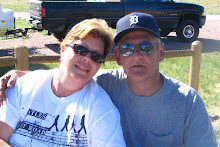It’s Cooling off in Colorado . . . Snow expected above 7,000 feet
Our winterizing weekend is just around the corner. Here’s the list we use at the end of each season and again after we’ve decided on a nice weekend - spontaneous winter getaway trip to our favorite local State Park. Because we park and store our RV at our home in an uncovered and unheated area, we must do a complete winterization on the rig. Your winterization list will vary depending on where you are able to store your RV.
• Give your rig a good washing. This gives you the chance to check all window seals, seams, vents and siding. Roll out the awning and give it a good cleaning and check-up too. Wait until your awning is completely dry (top and bottom) before you roll it up. Take this time to also clean the screens and windows from the inside. A good vacuuming is a must. You never know what might be lurking under the cushions or in and around the mattress. I once found a half-eaten PB&J left by one of the grandkids. A nice winter snack for passerby pests. Even the smallest of cracker crumbs can be a feast for a family of ants. I vacuum everything – top to bottom – all cupboards and storage areas.
• The sun is intense at 5,280 . . . close your window shades while in storage – it prevents sun fade on the interior. (We also keep our shades closed whenever the rig is parked during our RVing season. Another tip: Keep the shades up when bouncing down the road; this will reduce shade and cord wear, and keeps the shades from banging on and scratching at the screens and rubber seals.)
• Check out what you have in your exterior (and interior) storage areas/compartments and clean out (as necessary) items that can’t weather the weather. Any oils, fluids or cans should be removed – you don’t want anything freezing and exploding.
• Tire care: inflate them to the maximum stated cold pressure level – this will avoid flat spots next year. No matter where you store your vehicle, it’s a good idea to put planks under your tires and all wheels should be chocked. Since we’ve had such a cool summer this year, I’ve noticed we’ve been inundated more than normal with bugs, spiders and mice around the exterior of our house than during our very warm summers. Since we store our RV here at home – I’m going to try the dryer sheet trick this year. The pests don’t like the smell. Place a few dryer sheets next to your tires between the chocks, and also shove a dryer sheet into any open area, hole, crease, etc.; on the underside of your trailer . . helps keep the rig pest free.
• Defrost, clean and wipe down your fridge and freezer. Don’t forget to blow out the drain lines for the fridge to prevent the line from freezing and future refrigerator issues. Keep an open box of baking soda in both the fridge and freezer. You don’t want the fridge smelling like an old cooler next year. It works very well – just as it does for the fridge in the house.
• Be sure to cover your air conditioning unit and TV antenna with a covers designed to fit and protect. Critical!
• Pipes and Tanks: Here’s the fun part and the MOST IMPORTANT of all your winterizing chores. Drain and flush the black and grey tanks first. Then drain the fresh water system, and utilize an air compressor to blow out the lines – keeping all faucets (hot and cold) wide open during this process. Someone should watch from inside to confirm there isn’t a single drop of water left coming out of the faucets. Be sure to open up tub and shower lines too. Next, be sure to remove drain plugs from your water heater, refrigerator and ice maker (if you have one). Last year we completely missed blowing out the little plastic inlet line in the toilet. Big mistake. The small amount of water left in the inlet to the toilet froze and split, and cost us a waterless weekend on our first trip of the year (our shakedown cruise). . and then another $200 at the RV store to buy a replacement john!
• After you are sure all of the water has been flushed and blown out of the lines, it’s time to finalize the process with a good RV antifreeze product. Pour a little down your sinks and in the shower. This will protect any water left in the P-traps from freezing. We also pump antifreeze into the black, grey and fresh water tanks to keep any puddles left on the bottom of these tanks from freezing.
• The best way to protect our trailer batteries is to unhook them and store in an area that won’t freeze. Be sure your battery fluids are topped off before storing. For the propane tanks, make sure the main valve on the tanks are shut off.
• And the finishing touch . . . bring in the slide-outs and cover your unit, leaving one of the vents open just a bit for a little air flow.
A good winterizing ensures our first RVing adventure next year will go smoothly. We’re serious about our RVing and serious about protecting our investment. We want to be on the road as much as possible and good upkeep on the unit it worth every minute of time and every dollar spent. Happy RVing!!!
9/20/2009
Subscribe to:
Post Comments (Atom)

No comments:
Post a Comment